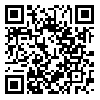Volume 10, Issue 5 (September & October 2019)
BCN 2019, 10(5): 409-418 |
Back to browse issues page
1- Department of Biomedical Engineering, School of Electrical, Computer & Biomedical Engineering, Amirkabir University of Technology, Tehran, Iran.
Abstract:
Introduction: Many theories have been proposed about the etiology of autism. One is related to brain connectivity in patients with autism. Several studies have reported brain connectivity changes in autism disease. This study was performed on Electroencephalogram (EEG) studies that evaluated patients with autism, using functional brain connectivity, and compared them with typically-developing individuals.
Methods: Three scientific databases of ScienceDirect, Medline (PubMed), and BioMed Central were systematically searched through their online search engines. Comprehensive Meta-analysis software analyzed the obtained data.
Results: The systematic search led to 10 papers, in which EEG coherence was used to obtain the brain connectivity of people with autism. To determine the effect size, Cohen’s d parameter was used. In the first meta-analysis, the study of the maximum effect size was considered, and all significant effect sizes were evaluated in the second meta-analysis. The effect size was assessed using a random-effects model in both meta-analyses. The results of the first meta-analysis indicated that heterogeneity was not present among the studies (Q=13.345, P>0.1). The evaluation of all effect sizes in the second meta-analysis showed a significant lack of homogeneity among the studies (Q=56.984, P=0.0001).
Conclusion: On the whole, autism was found to be related to neural connectivity, and the present research showed the difference in the EEG coherence of people with autism and healthy people. These conclusions require further studies with more extensive data, considering different brain regions, and novel analysis techniques for assessing brain connectivity.
Methods: Three scientific databases of ScienceDirect, Medline (PubMed), and BioMed Central were systematically searched through their online search engines. Comprehensive Meta-analysis software analyzed the obtained data.
Results: The systematic search led to 10 papers, in which EEG coherence was used to obtain the brain connectivity of people with autism. To determine the effect size, Cohen’s d parameter was used. In the first meta-analysis, the study of the maximum effect size was considered, and all significant effect sizes were evaluated in the second meta-analysis. The effect size was assessed using a random-effects model in both meta-analyses. The results of the first meta-analysis indicated that heterogeneity was not present among the studies (Q=13.345, P>0.1). The evaluation of all effect sizes in the second meta-analysis showed a significant lack of homogeneity among the studies (Q=56.984, P=0.0001).
Conclusion: On the whole, autism was found to be related to neural connectivity, and the present research showed the difference in the EEG coherence of people with autism and healthy people. These conclusions require further studies with more extensive data, considering different brain regions, and novel analysis techniques for assessing brain connectivity.
Type of Study: Review |
Subject:
Computational Neuroscience
Received: 2018/04/27 | Accepted: 2018/10/7 | Published: 2019/09/1
Received: 2018/04/27 | Accepted: 2018/10/7 | Published: 2019/09/1
| Rights and permissions | |
 |
This work is licensed under a Creative Commons Attribution-NonCommercial 4.0 International License. |





